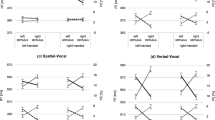Summary
Choice-reaction time is known to depend on the spatial correspondence of stimulus and response, even if the stimulus location is irrelevant to the task (Simon effect). An experiment investigated whether this effect depends on stimulus complexity — i. e., on whether properties of the stimulus render stimulus discrimination easy or difficult. It was hypothesized that high demands on discrimination slow down the processing of stimulus identity in relation to location, so that the facilitating or conflicting location code has more time to decay, thus losing impact on response selection. In fact, the results revealed an effect of irrelevant spatial S-R correspondence with easy, but not with difficult, stimulus discrimination. This finding resolves an apparent contradiction between the results of several previous experiments on the Simon effect.
Similar content being viewed by others
References
Brebner, J., Shephard, M., & Cairney, P. (1972). Spatial relationships and S-R compatibility. Acta Psychologica, 36, 1–15.
Fitts, P. M., & Seeger, C. M. (1953). S-R compatibility: Spatial characteristics of stimulus and response codes. Journal of Experimental Psychology, 46, 199–210.
Hommel, B. (1993 a). The relationship between stimulus processing and response selection in the Simon task: Evidence for a temporal overlap. Psychological Research, 55, 280–290.
Hommel, B. (1993 b). The role of attention for the Simon effect. Psychological Research, 55, 208–222.
Hommel, B. (1993 c). Spontaneous decay of response code activation. Manuscript submitted for publication.
Lamberts, K., Tavernier, G., & d'Ydewalle, G. (1992). Effects of multiple reference points in spatial stimulus-response compatibility. Acta Psychologica, 79, 115–130.
McCann, R. S., & Johnston, J. C. (1992). Locus of the single-channel bottleneck in dual-task interference. Journal of Experimental Psychology: Human Perception and Performance, 18, 471–484.
Neumann, O. (1980). Informationsselektion und Handlungssteuerung. Unpublished doctoral dissertation. University of Bochum, Germany.
Nicoletti, R., & Umiltá, C. (1989). Splitting visual space with attention. Journal of Experimental Psychology: Human Perception and Performance, 15, 164–169.
Pashler, H. (1987). Detecting conjunctions of color and form: Reassessing the serial search hypothesis. Perception & Psychophysics, 41, 191–201.
Proctor, R. W., & Reeve, T. G. (Eds.) (1990). Stimulus-response compatibility. Amsterdam: North-Holland.
Quinlan, P. T., & Humphreys, G. W. (1987). Visual search for targets defined by combinations of color, shape, and size: An examination of the task constraints on feature and conjunction searches. Perception & Psychophysics, 41, 455–472.
Simon, J. R., & Rudell, A. P. (1967). Auditory S-R compatibility: The effect of an irrelevant cue on information processing. Journal of Applied Psychology, 51, 300–304.
Stoffer, T. H. (1991). Attentional focussing and spatial stimulus-response compatibility. Psychological Research, 53, 127–135.
Treisman, A., & Gelade, G. (1980). A feature-integration theory of attention. Cognitive Psychology, 12, 97–136.
Umiltá, C., & Liotti, M. (1987). Egocentric and relative spatial codes in S-R compatibility. Psychological Research, 49, 81–90.
Umiltà, C., & Nicoletti, R. (1985). Attention and coding effects in S-R compatibility due to irrelevant spatial cues. In M. I. Posner & O. S. M. Marin (Eds.), Attention and Performance XI (pp. 457–471). Hillsdale, NJ: Erlbaum.
Umiltá, C., & Nicoletti, R. (1992). An integrated model of the Simon effect. In J. Alegria, D. Holender, J. Junça de Morais, & M. Radeau (Eds.), Analytic approaches to human cognition (pp. 331–350). Amsterdam:North-Holland.
Wallace, R. J. (1971). S-R compatibility and the idea of a response code. Journal of Experimental Psychology, 88, 354–360.
Author information
Authors and Affiliations
Additional information
The other central argument rests on findings of Stoffer (1991) obtained with a single frame. These, however, have recently been challenged by Hommel (1993 b).
Rights and permissions
About this article
Cite this article
Hommel, B. Effects of irrelevant spatial S-R compatibility depend on stimulus complexity. Psychol. Res 56, 179–184 (1994). https://doi.org/10.1007/BF00419705
Issue Date:
DOI: https://doi.org/10.1007/BF00419705




